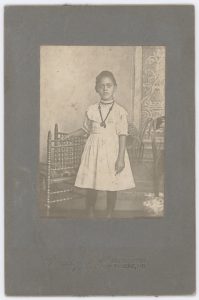Curating Hidden Collections & the Black Archive takes as a starting point the necessary but fraught nature of researching vintage portrait photographs of unidentified sitters, objects of familial and personal nature, for their preservation and presentation on-line. Obtained in Maryland and donated to the University of Delaware in 2001, the fifty-three photographs arrived as “found objects” and became known as “The Baltimore Collection.” The University Library later established a Black Portrait Photograph Collection that includes newly acquired objects.
Foundational research on “The Baltimore Collection” was undertaken during the fall 2017 seminar Curating Hidden Collections & the Black Archive. The“Black Archive Spring 2021 Seminar” researched eleven objects in the newly constituted Black Portrait Photograph collection. The 2023 cohort developed metadata for more than twenty new portrait photographs, many from the state of Texas. The combined efforts of these University of Delaware student scholars furthers our understanding of the photographs and the wider histories they inform. This research includes: the study of the photographs as objects of material and visual culture; consideration of the sitters, photography studios, photographic portraiture, clothing, and self-fashioning trends in the U.S., Black Baltimore, and the Mid-Atlantic region; early African American portrait photography; and an introduction to archival and theoretical challenges in making this collection and others like it available to the public.
Where and when Americans have expected or wanted to see race, as well as where and when we don’t want to see it, tells us a great deal about how we negotiate our ambivalent relation to the historical legacy of racialization. That ambivalence has informed the ways photographs are classified and interpreted. ~ Coco Fusco, “Racial Time, Racial Marks, Racial Metaphors,” Only Skin Deep: Changing Visions of the American Self (2003), 47-48.
Among the issues considered are: How might collections such as these be presented on-line beyond the indexical or “catalog” metadata? What biases, institutional and historical, need we be attentive to in terms of metadata, preservation and curating? What practical, technological, pedagogical and theoretical applications are best suited for making these objects, their conservation, and research accessible and teachable across disciplines and platforms? What new areas of knowledge are generated through the consideration of this collection thusly?
Our discussion continues……


